Unit 1 Great Scientists reading 课件(共30张PPT)
文档属性
| 名称 | Unit 1 Great Scientists reading 课件(共30张PPT) | 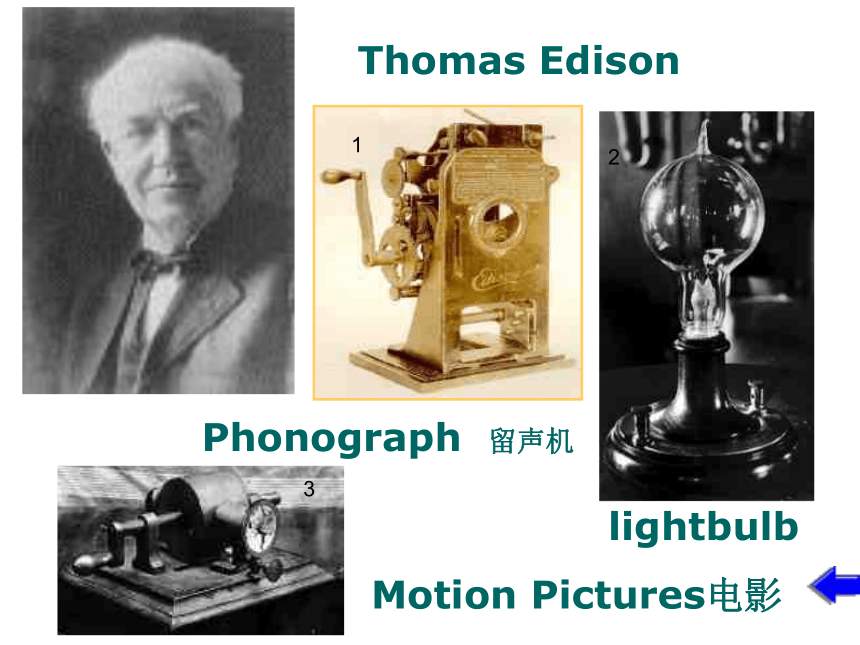 | |
| 格式 | zip | ||
| 文件大小 | 1.9MB | ||
| 资源类型 | 教案 | ||
| 版本资源 | 人教版(新课程标准) | ||
| 科目 | 英语 | ||
| 更新时间 | 2020-09-01 22:21:46 | ||
图片预览

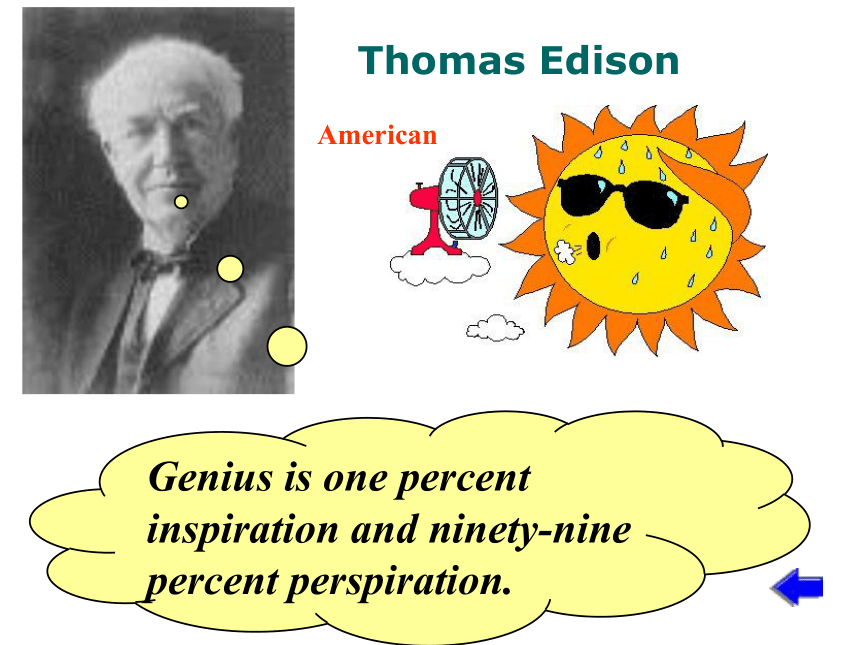
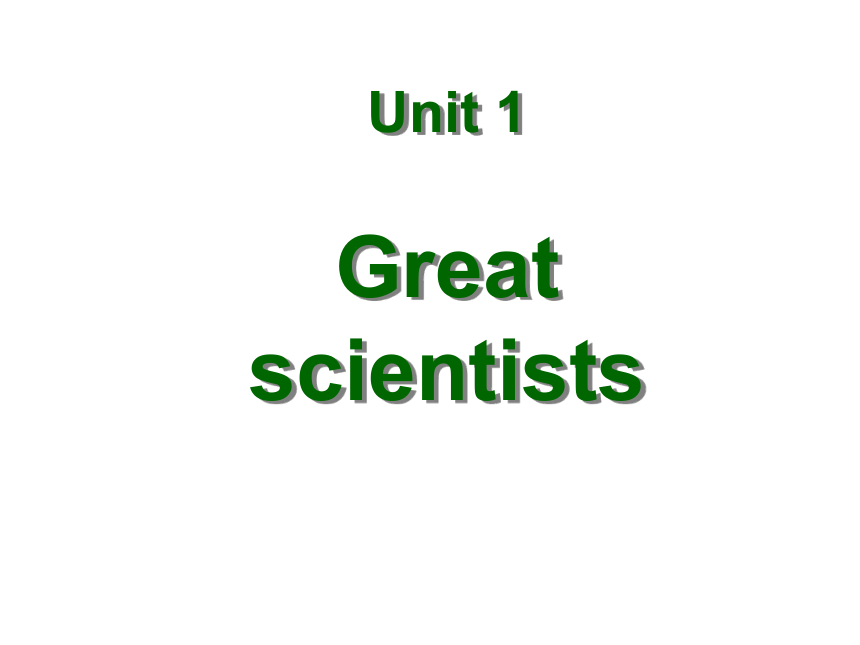
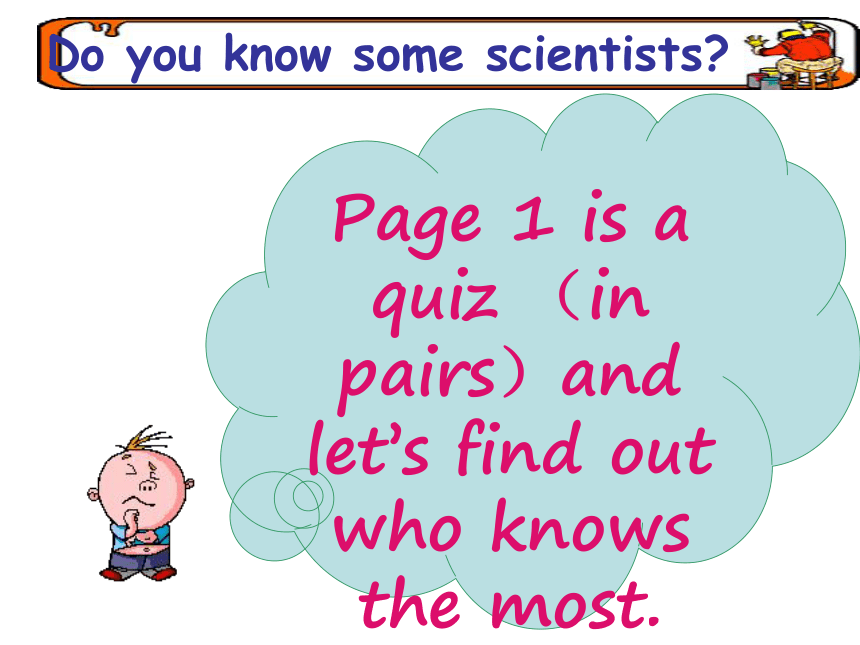
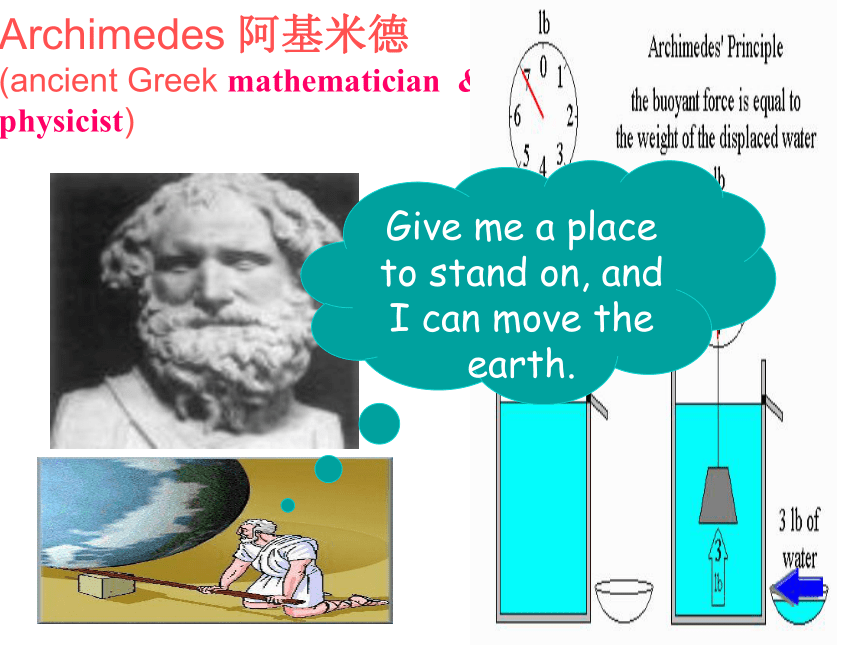
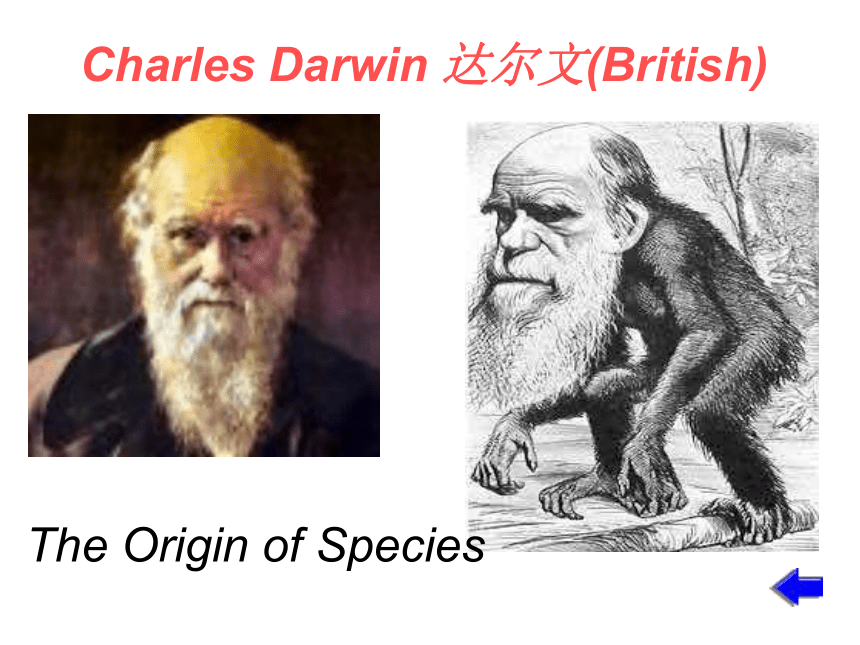
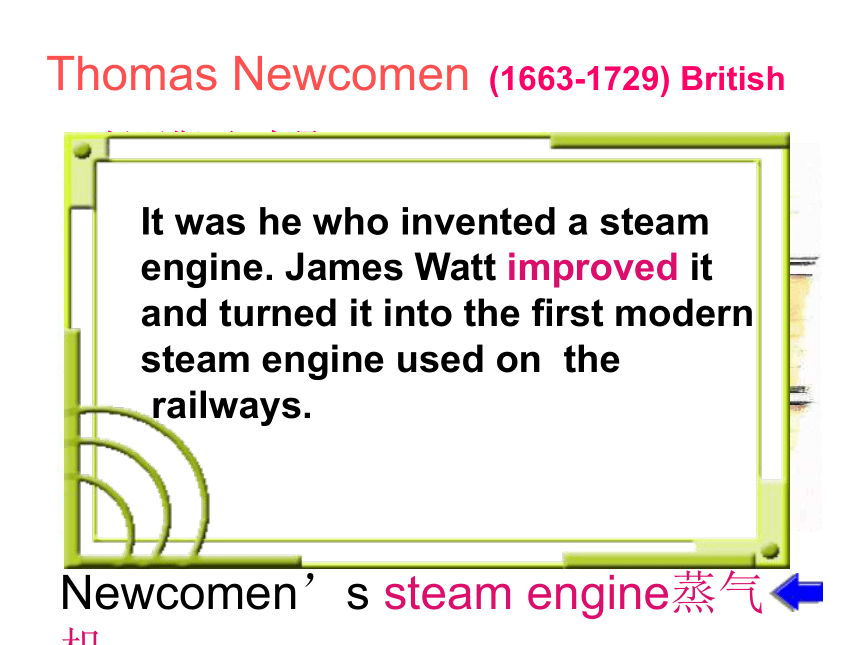
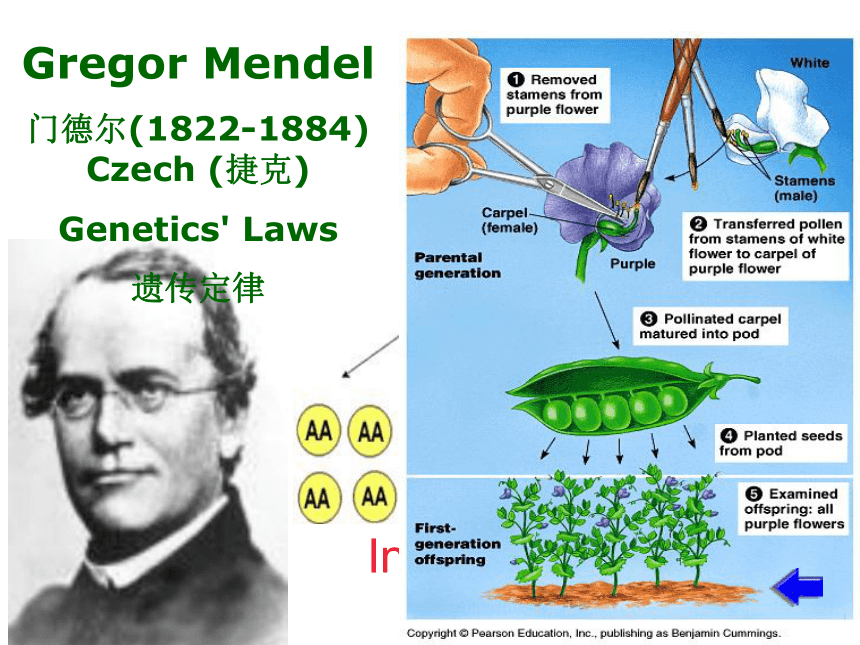
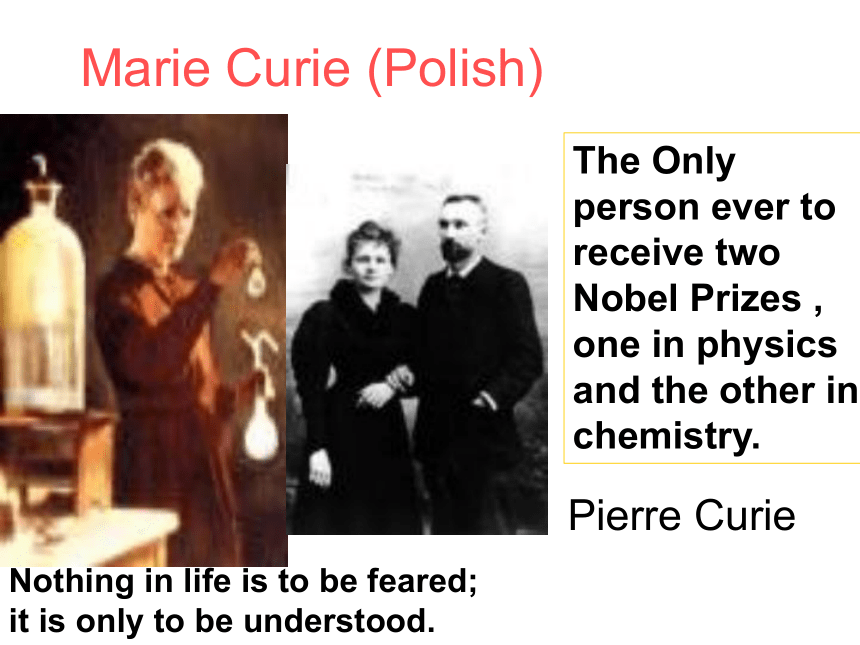
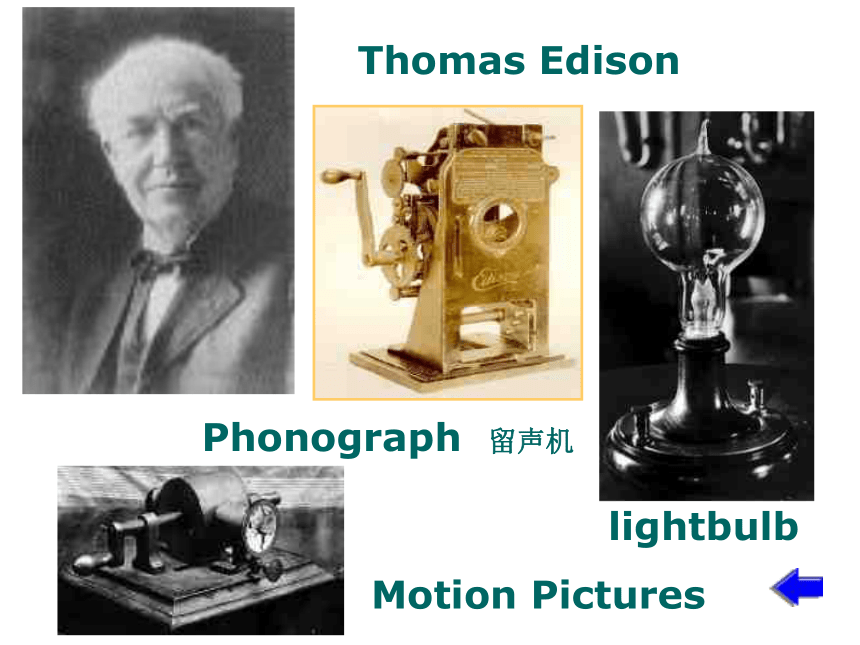
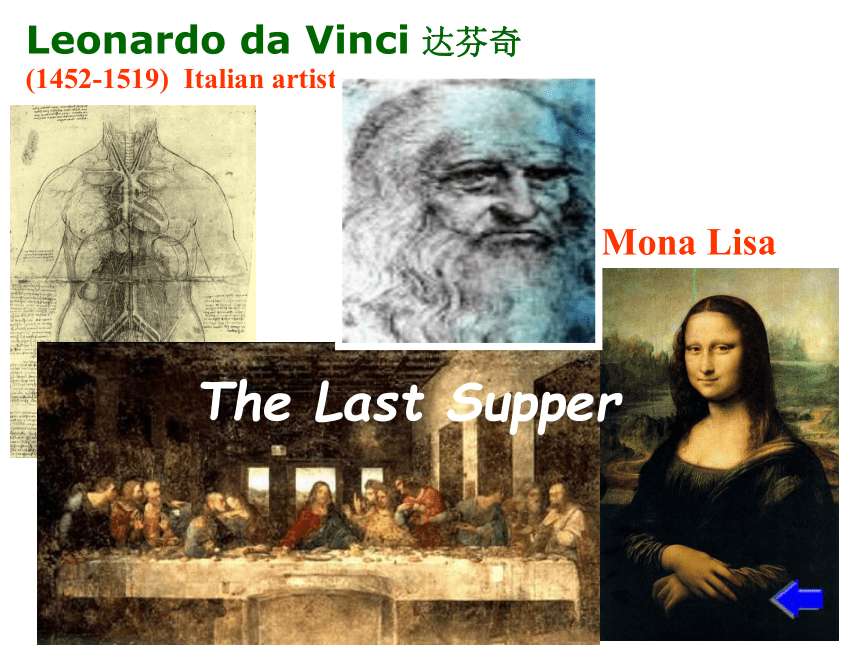
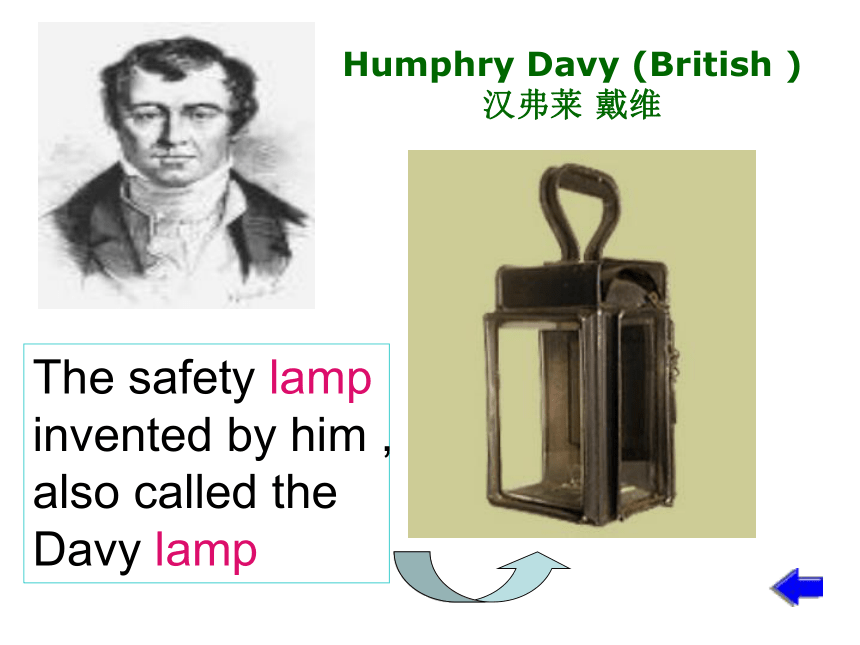
文档简介
(共30张PPT)
Thomas
Edison
Thomas
Edison
Phonograph
留声机
lightbulb
Motion
Pictures电影
1
2
3
Thomas
Edison
Thomas
Edison
Genius
is
one
percent
inspiration
and
ninety-nine
percent
perspiration.
American
Unit
1
Great
scientists
Page
1
is
a
quiz
(in
pairs)and
let’s
find
out
who
knows
the
most.
Do
you
know
some
scientists?
Archimedes
阿基米德
(ancient
Greek
mathematician
&
physicist)
Give
me
a
place
to
stand
on,
and
I
can
move
the
earth.
Charles
Darwin
达尔文(British)
The
Origin
of
Species
Thomas
Newcomen
(1663-1729)
British
托玛斯
·纽克曼
Newcomen’s
steam
engine蒸气机
It
was
he
who
invented
a
steam
engine.
James
Watt
improved
it
and
turned
it
into
the
first
modern
steam
engine
used
on
the
railways.
Inheritance遗传
Gregor
Mendel
门德尔(1822-1884)
Czech
(捷克)
Genetics'
Laws
遗传定律
The
Only
person
ever
to
receive
two
Nobel
Prizes
,
one
in
physics
and
the
other
in
chemistry.
Marie
Curie
(Polish)
Pierre
Curie
Nothing
in
life
is
to
be
feared;
it
is
only
to
be
understood.
Thomas
Edison
Thomas
Edison
Phonograph
留声机
lightbulb
Motion
Pictures
Leonardo
da
Vinci
达芬奇(1452-1519)
Italian
artist
The
Last
Supper
Mona
Lisa
The
safety
lamp
invented
by
him
,
also
called
the
Davy
lamp
Humphry
Davy
(British
)
汉弗莱
戴维
Zhang
Heng
seismograph
地动仪
Stephen
Hawking
斯帝芬·
霍金
astronomer天文学家
The
theory
about
black
holes
A
Brief
History
of
Time
《时间简史》
Q
Answers
1.
2.
3.
4.
5.
6.
7.
8.
9.
10.
Archimedes
Charles
Darwin
Thomas
Newcomen
Gregor
Mendel
Marie
Curie
Thomas
Edison
Leonardo
da
Vinci
Sir
Humphry
Davy
Zhang
Heng
Stephen
Hawking
Good
qualities
of
the
great
scientists
They
all...
Brainstorming
intelligent,
modest(谦虚),
patient,
creative
,
hard-working/diligent(勤奋),
imaginative,
curious
Unselfish/
generous(慷慨无私),
determined(坚定)/persistent(坚持),
confident
,
brave/fearless(无畏),
co-operative(合作精神),
positive,
pleasant,
polite,
energetic,
strict,
careful
Do
you
know
how
to
prove
a
new
idea in
scientific
research?
seven
stages
draw
a
conclusion
find
a
problem
make
up
a
question
think
of
a
method
collect
results
analyse
the
results
Find
supporting
evidence
put
the
7
stages
in
right
order
draw
a
conclusion
think
of
a
method
collect
results
make
up
a
question
find
a
problem
analyse
the
results
Find
supporting
evidence
Pre-reading
发现问题,
形成研究课题,
找出研究方法,
收集材料,
分析材料,
寻找证据,
得出结论。
Reading
John
Snow
Defeats
“King
Cholera”
John
Snow
British
(
1813~
1858)
a
legendary(传奇的)
doctor
in
the
history
of
public
health,
epidemiology(流行病学)
and
anesthesiology(麻醉学)
What
do
you
know
about
Cholera?
Cholera
is
the
illness
caused
by
a
bacterium
called
vibrio
cholera(霍乱弧菌).
It
infects
people’s
intestines(肠),
causing
diarrhea(腹泻),
vomiting(呕吐的
)
and
leg
cramps(腿痛性痉挛).
Infectious,
do
great
harm,
difficult
to
cure
Skim:the
main
idea
of
the
passage
John
Snow
was
a
well-known
doctor
in
London.
The
cause
of
Cholera
was
polluted
water.
The
source
of
all
drinking
water
should
be
examined.
How
did
John
Snow
collect,
analyze
data
and
find
the
cause
of
the
disease
and
solved
it
.
The
passage
is
written
as
a
report
of
an
experiment
to
prove
a
new
idea
or
theory.
.
Read
the
passage
and
number
these
events
in
the
order
that
they
happened.
⒈
An
outbreak
of
cholera
hit
London
in
1854.
⒉
John
Snow
began
to
test
two
theories.
⒊
John
Snow
investigated
two
streets
where
the
outbreak
was
very
severe.
⒋
John
Snow
marked
the
deaths
on
a
map.
⒌
He
found
that
most
of
the
deaths
were
near
a
water
pump.
⒍
He
had
the
handle
removed
from
the
water
pump.
⒎
He
announced
that
the
water
carried
the
disease.
⒏
King
Cholera
was
defeated.
Task:
Read
the
passage
again
and
fill
in
this
form:
Steps(7):
What/How?
1.Find
a
problem
2.Make
up
a
question
3.Think
of
a
method
4.Collect
results
5.Analyse
results
6.
Find
supporting
evidence
7.Make
a
conclusion
Steps:
What/How?
1.Find
a
problem
2.Make
up
a
question
3.Think
of
a
method
4.Collect
results
What
causes
cholera?(抽象)
Which
theory
is
correct?(具体)
Collect
information
on
those
who
were
ill
or
dead
and
where
they
got
their
water
Mark
information
on
a
map
to
find
out
where
people
died
or
did
not
die
A
map
of
Broad
Street
What
method
did
he
use?
Broad
Street
Many
deaths
happened
here.
No
death
happened
here.
The
water
from
the
pump
was
to
blame.
Public
house
6.Find
supporting
evidence
7.Make
a
conclusion
5.Analyse
results
Analyze
the
water
to
see
if
that
is
the
cause
of
the
illness
Find
two
other
deaths
in
another
part
to
make
sure
of
the
conclusion
The
water
is
to
blame.
The
source
of
all
drinking
water
should
be
examined.
Thomas
Edison
Thomas
Edison
Phonograph
留声机
lightbulb
Motion
Pictures电影
1
2
3
Thomas
Edison
Thomas
Edison
Genius
is
one
percent
inspiration
and
ninety-nine
percent
perspiration.
American
Unit
1
Great
scientists
Page
1
is
a
quiz
(in
pairs)and
let’s
find
out
who
knows
the
most.
Do
you
know
some
scientists?
Archimedes
阿基米德
(ancient
Greek
mathematician
&
physicist)
Give
me
a
place
to
stand
on,
and
I
can
move
the
earth.
Charles
Darwin
达尔文(British)
The
Origin
of
Species
Thomas
Newcomen
(1663-1729)
British
托玛斯
·纽克曼
Newcomen’s
steam
engine蒸气机
It
was
he
who
invented
a
steam
engine.
James
Watt
improved
it
and
turned
it
into
the
first
modern
steam
engine
used
on
the
railways.
Inheritance遗传
Gregor
Mendel
门德尔(1822-1884)
Czech
(捷克)
Genetics'
Laws
遗传定律
The
Only
person
ever
to
receive
two
Nobel
Prizes
,
one
in
physics
and
the
other
in
chemistry.
Marie
Curie
(Polish)
Pierre
Curie
Nothing
in
life
is
to
be
feared;
it
is
only
to
be
understood.
Thomas
Edison
Thomas
Edison
Phonograph
留声机
lightbulb
Motion
Pictures
Leonardo
da
Vinci
达芬奇(1452-1519)
Italian
artist
The
Last
Supper
Mona
Lisa
The
safety
lamp
invented
by
him
,
also
called
the
Davy
lamp
Humphry
Davy
(British
)
汉弗莱
戴维
Zhang
Heng
seismograph
地动仪
Stephen
Hawking
斯帝芬·
霍金
astronomer天文学家
The
theory
about
black
holes
A
Brief
History
of
Time
《时间简史》
Q
Answers
1.
2.
3.
4.
5.
6.
7.
8.
9.
10.
Archimedes
Charles
Darwin
Thomas
Newcomen
Gregor
Mendel
Marie
Curie
Thomas
Edison
Leonardo
da
Vinci
Sir
Humphry
Davy
Zhang
Heng
Stephen
Hawking
Good
qualities
of
the
great
scientists
They
all...
Brainstorming
intelligent,
modest(谦虚),
patient,
creative
,
hard-working/diligent(勤奋),
imaginative,
curious
Unselfish/
generous(慷慨无私),
determined(坚定)/persistent(坚持),
confident
,
brave/fearless(无畏),
co-operative(合作精神),
positive,
pleasant,
polite,
energetic,
strict,
careful
Do
you
know
how
to
prove
a
new
idea in
scientific
research?
seven
stages
draw
a
conclusion
find
a
problem
make
up
a
question
think
of
a
method
collect
results
analyse
the
results
Find
supporting
evidence
put
the
7
stages
in
right
order
draw
a
conclusion
think
of
a
method
collect
results
make
up
a
question
find
a
problem
analyse
the
results
Find
supporting
evidence
Pre-reading
发现问题,
形成研究课题,
找出研究方法,
收集材料,
分析材料,
寻找证据,
得出结论。
Reading
John
Snow
Defeats
“King
Cholera”
John
Snow
British
(
1813~
1858)
a
legendary(传奇的)
doctor
in
the
history
of
public
health,
epidemiology(流行病学)
and
anesthesiology(麻醉学)
What
do
you
know
about
Cholera?
Cholera
is
the
illness
caused
by
a
bacterium
called
vibrio
cholera(霍乱弧菌).
It
infects
people’s
intestines(肠),
causing
diarrhea(腹泻),
vomiting(呕吐的
)
and
leg
cramps(腿痛性痉挛).
Infectious,
do
great
harm,
difficult
to
cure
Skim:the
main
idea
of
the
passage
John
Snow
was
a
well-known
doctor
in
London.
The
cause
of
Cholera
was
polluted
water.
The
source
of
all
drinking
water
should
be
examined.
How
did
John
Snow
collect,
analyze
data
and
find
the
cause
of
the
disease
and
solved
it
.
The
passage
is
written
as
a
report
of
an
experiment
to
prove
a
new
idea
or
theory.
.
Read
the
passage
and
number
these
events
in
the
order
that
they
happened.
⒈
An
outbreak
of
cholera
hit
London
in
1854.
⒉
John
Snow
began
to
test
two
theories.
⒊
John
Snow
investigated
two
streets
where
the
outbreak
was
very
severe.
⒋
John
Snow
marked
the
deaths
on
a
map.
⒌
He
found
that
most
of
the
deaths
were
near
a
water
pump.
⒍
He
had
the
handle
removed
from
the
water
pump.
⒎
He
announced
that
the
water
carried
the
disease.
⒏
King
Cholera
was
defeated.
Task:
Read
the
passage
again
and
fill
in
this
form:
Steps(7):
What/How?
1.Find
a
problem
2.Make
up
a
question
3.Think
of
a
method
4.Collect
results
5.Analyse
results
6.
Find
supporting
evidence
7.Make
a
conclusion
Steps:
What/How?
1.Find
a
problem
2.Make
up
a
question
3.Think
of
a
method
4.Collect
results
What
causes
cholera?(抽象)
Which
theory
is
correct?(具体)
Collect
information
on
those
who
were
ill
or
dead
and
where
they
got
their
water
Mark
information
on
a
map
to
find
out
where
people
died
or
did
not
die
A
map
of
Broad
Street
What
method
did
he
use?
Broad
Street
Many
deaths
happened
here.
No
death
happened
here.
The
water
from
the
pump
was
to
blame.
Public
house
6.Find
supporting
evidence
7.Make
a
conclusion
5.Analyse
results
Analyze
the
water
to
see
if
that
is
the
cause
of
the
illness
Find
two
other
deaths
in
another
part
to
make
sure
of
the
conclusion
The
water
is
to
blame.
The
source
of
all
drinking
water
should
be
examined.
